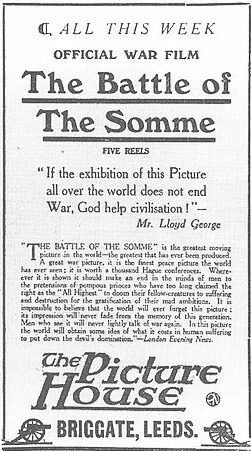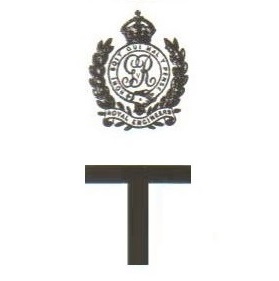Related Research Articles

The Battle of the Somme, also known as the Somme offensive, was a battle of the First World War fought by the armies of the British Empire and the French Third Republic against the German Empire. It took place between 1 July and 18 November 1916 on both sides of the upper reaches of the river Somme in France. The battle was intended to hasten a victory for the Allies. More than three million men fought in the battle, of whom one million were either wounded or killed, making it one of the deadliest battles in all of human history.

Trench warfare is a type of land warfare using occupied lines largely comprising military trenches, in which combatants are well-protected from the enemy's small arms fire and are substantially sheltered from artillery. It became archetypically associated with World War I (1914–1918), when the Race to the Sea rapidly expanded trench use on the Western Front starting in September 1914.

The Battle of the Somme, is a 1916 British documentary and propaganda war film, shot by two official cinematographers, Geoffrey Malins and John McDowell. The film depicts the British Expeditionary Force during the preliminaries and early days of the Battle of the Somme. The film premièred in London on 10 August 1916 and was released generally on 21 August. The film shows trench warfare, marching infantry, artillery firing on German positions, British troops waiting to attack on 1 July, the treatment of wounded British and German soldiers, British and German dead and captured German equipment and positions. A scene during which British troops crouch in a ditch then "go over the top" was staged for the camera behind the lines.

The 29th Division, known as the Incomparable Division, was an infantry division of the British Army, formed in early 1915 by combining various Regular Army units that had been acting as garrisons around the British Empire. Under the command of Major-General Aylmer Hunter-Weston, the division fought throughout the Gallipoli Campaign, including the original landing at Cape Helles. From 1916 to the end of the war the division fought on the Western Front in Belgium and France.
The 36th (Ulster) Division was an infantry division of the British Army, part of Lord Kitchener's New Army, formed in September 1914. Originally called the Ulster Division, it was made up of mainly members of the Ulster Volunteer Force, who formed thirteen additional battalions for three existing regiments: the Royal Irish Fusiliers, the Royal Irish Rifles and the Royal Inniskilling Fusiliers. The division served from October 1915 on Western Front as a formation of the British Army during the Great War.

The 18th (Eastern) Division was an infantry division of the British Army formed in September 1914 during the First World War as part of the K2 Army Group, part of Lord Kitchener's New Armies. From its creation the division trained in England until 25 May 1915 when it landed in France and spent the duration of the First World War in action on the Western Front, becoming one of the elite divisions of the British Army. During the Battle of the Somme in the latter half of 1916, the 18th Division was commanded by Major General Ivor Maxse.

William Frederick McFadzean VC was a British recipient of the Victoria Cross (VC), the highest and most prestigious award for gallantry in the face of the enemy that can be awarded to British and Commonwealth forces. He was posthumously awarded the VC for his actions on the opening day of the Battle of the Somme.

The Attacks on the Butte de Warlencourt describe a tactical incident during the Battle of the Somme. The Butte de Warlencourt is an ancient burial mound off the Albert–Bapaume road, north-east of Le Sars in the Somme département in northern France. It is located on the territory of the commune of Warlencourt-Eaucourt and slightly north of a minor road to Gueudecourt and Eaucourt l'Abbaye. During the First World War, German troops constructed deep dugouts in the Butte and surrounded it by several belts of barbed wire, making it a formidable defensive position in advance of Gallwitz Riegel. After the Battle of Flers–Courcelette, the view from the Butte dominated the new British front line and was used by the Germans for artillery observation.

Battlefield archaeology is a sub-discipline of archaeology which studies the material remains and topography of a battlefield to understand a conflict. Archaeological battlefields consist of skirmishes, sieges, camps, and training sites. The study of the relationships and contexts of the material by-products of war give an alternate account to the version recorded in a history book, poem, or witness account, which may be constructed though bias, or may present only a limited perspective of the events. Examination of these locations gives insight to what tactics were being used, weapon modifications, and battle formations. It is not considered distinct from Military archaeology or Recceology.

The 2nd Dragoon Guards (Queen's Bays) was a cavalry regiment of the British Army. It was first raised in 1685 by the Earl of Peterborough as the Earl of Peterborough's Regiment of Horse by merging four existing troops of horse.
Peter Arthur Barton is a British military historian, author and filmmaker specialising in trench warfare during World War I. He has published extensively on military mining and aspects of battlefield archaeology on the Western Front, and led archaeological excavations that have been featured in several Time Team episodes. His work has led to the rediscovery of many tunnels, wartime panoramas and mass graves of soldiers.

The Battle of the Boar's Head was an attack on 30 June 1916 at Richebourg-l'Avoué in France, during the First World War. Troops of the 39th Division, XI Corps in the First Army of the British Expeditionary Force (BEF), advanced to capture the Boar's Head, a salient held by the German 6th Army. Two battalions of the 116th Brigade, with one battalion forming carrying parties, attacked the German front position before dawn on 30 June. The British took and held the German front line trench and the second trench for several hours, before retiring to their lines having lost 850–1,366 casualties.

The Beaumont-Hamel Newfoundland Memorial is a memorial site in France dedicated to the commemoration of Dominion of Newfoundland forces members who were killed during World War I. The 74-acre (300,000 m2) preserved battlefield park encompasses the grounds over which the Newfoundland Regiment made their unsuccessful attack on 1 July 1916 during the first day of the Battle of the Somme.
David Kenyon is a British archaeologist and military historian. He was one of the military advisors on the film War Horse.
Finding the Fallen is a UK-based documentary TV series by Yap Productions developed for the History Channel / Discovery Channel in which a team of archaeologists, historians and forensic experts work to identify unknown World War I soldiers and finally lay them to rest.
Livens Large Gallery Flame Projectors were large experimental flamethrowers used by the British Army in World War I, named after their inventor, Royal Engineers officer William Howard Livens.

The 25th Battalion, CEF was a unit in the Canadian Expeditionary Force during the Great War. It was the second infantry battalion of ten to be raised in Nova Scotia during the war. The 25th served in Belgium and France as part of the 5th Canadian Brigade, 2nd Canadian Division from 16 September 1915 until the end of the war. Regimental headquarters were established at the Halifax Armouries, with recruitment offices in Sydney, Amherst, New Glasgow, Truro and Yarmouth. Of the 1000 Nova Scotians that started with the battalion, after the first year of fighting, 100 were left in the battalion, while 900 men were killed, taken prisoner, missing or injured.

The 252nd Tunnelling Company was one of the tunnelling companies of the Royal Engineers created by the British Army during World War I. The tunnelling units were occupied in offensive and defensive mining involving the placing and maintaining of mines under enemy lines, as well as other underground work such as the construction of deep dugouts for troop accommodation, the digging of subways, saps, cable trenches and underground chambers for signals and medical services. 252nd Tunnelling Company is particularly known for creating the Hawthorn Ridge mine during the Battle of the Somme 1916, which formed part of a series of mines that were placed beneath the German lines.

On the morning of 1 July 1916, the first day of the Battle of the Somme during World War I, underground explosive charges planted by British tunnelling units were detonated beneath the German front lines. The joint explosion of these mines ranks among the largest artificial non-nuclear explosions.

The Y Sap mine was an underground explosive charge, secretly planted by the British during the First World War and ready for 1 July 1916, the first day on the Somme. The mine was dug by the Tunnelling Companies of the Royal Engineers under a German machine-gun nest known as Blinddarm (appendix) in the front line, on the north side of the village of La Boisselle in the Somme département. The mine was named after Y Sap, the British trench from which the gallery was driven. It was one of 19 mines on the British sector to be blown at the start of the battle.
References
- ↑ Centre for First World War Studies
- ↑ Discovery Channel: Finding the Fallen
- ↑ "'World War One trench' recreated in Kent woodland". BBC News. 19 October 2021. Retrieved 19 October 2021.
- ↑ Moss, Richard (6 July 2010). "War Horse heads to English Heritage Festival of History for dramatic World War I trench recreation". Culture 24. Retrieved 7 July 2011.
- ↑ Elijah Howarth; F. R. Rowley; W. Ruskin Butterfield; Charles Madeley (1994). The Museums Journal. Museums Association. p. 23.